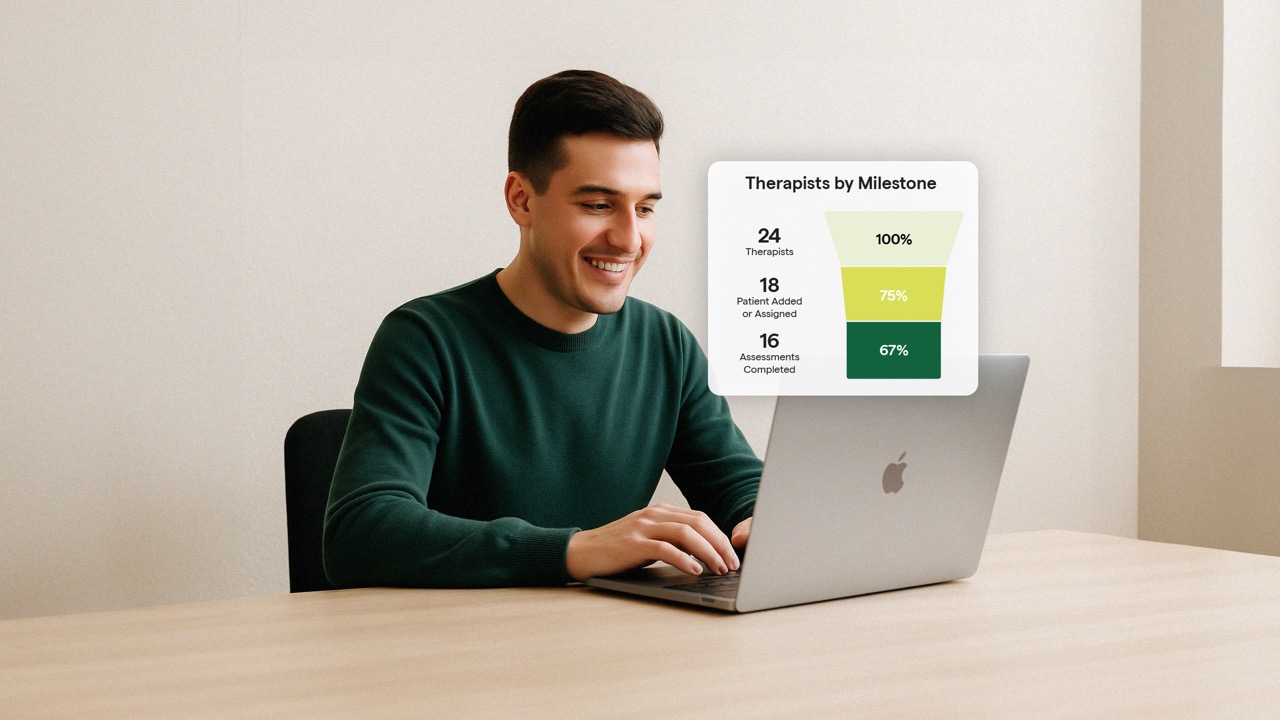
Research shows that Measurement-Based Care (MBC) has a substantial and positive impact on behavioral health treatment, from enhanced therapeutic alliance to improved clinical outcomes to lower cancellation rates. The adoption of MBC is rapidly gaining momentum across North America as clinics, hospitals and health systems prioritize its implementation to ensure services are high-quality, high-quality, evidence-based and meet evolving accreditation requirements. As this movement grows, clinicians are tasked with adjusting their workflows to ensure they realize the clinical value of the process in practice.
Given that MBC is a clinical process, it requires more than just assigning measures to clients in care. Effective MBC involves consistent, ongoing measurement. Most importantly, clinicians should leverage measures throughout care to drive collaborative discussions with clients that inform their treatment planning and decision-making.
Most clinicians are already adept at getting curious with clients about their symptoms and digging into the things that are impacting their wellness. Patient reported outcome measures (PROMs) simply act as a springboard for deeper client-clinician discussions, helping to signal when a client is off-track or when there is something impacting them that may not have surfaced without MBC.
While the process of MBC is simple, deeply integrating measures into care discussions and drawing the clinical value from them can be intimidating. Featuring our partners and MBC experts from the Yale MBC Collaborative, Dr. Jessica Barber and Dr. Amber Childs, this clinician guide features interactive clinical examples to demonstrate how MBC can be introduced and leveraged in session, highlighting helpful techniques to maximize the impact of this evidence-based practice.
But first, some background on the process of MBC, following the Collect, Share, Act model which can help you understand how to leverage MBC in practice:
Interactive Clinical Examples
To help ground the learning of these techniques, Dr. Barber and Dr. Childs led interactive clinical examples, demonstrating how MBC can be used in session with clients. Watch as the pair introduce the exercise and explain how it works:
Introducing MBC
Before you can practice MBC with clients, it’s extremely important to explain to your client what MBC is, its purpose, and how the measures will be used collaboratively in session to help inform their treatment goals, discussions and plans. Watch as Dr. Childs demonstrates how to do this with clients in order to engage them in the process:
Now that we have the basics down, let’s jump into some practical clinical examples of MBC:
Clinical Exercise 1
Watch the exercise below to see the learnings and techniques explained below applied in practice:
Let’s explore some of the techniques used in this exercise:
Leveraging the Value of Discrepancies and Finding Nuance in MBC Data
Sometimes a client’s results won’t align with one another, or they don’t exactly match what they’re sharing in session. Dr. Barber and Dr. Childs explain how these discrepancies can actually help drive more meaningful clinical discussions and uncover details you may not have otherwise identified:
Applying ‘Act’ to Make shared Decisions
Much of what happens during the ‘Share’ part of the MBC process can directly inform how you ‘Act’ or take action based on a client’s outcome data and your discussions with them. Dr. Barber explains the value of identifying elements in the ‘Share’ process that standout, and working collaboratively with your client to help inform both treatment decisions and approach.
Reporting Scores and Developing a Framework
These collaborative MBC discussions are possible because you have first shared your clients scores with them, inquired about what they mean to them, and had the opportunity to hear their perspective. This is the stage where you can work together with your client to determine if you both understand the results in the same way, and develop that shared framework that helps guide the session moving forward.
Clinical Exercise 2
Watch the exercise below to see the learnings and techniques explained below applied in practice:
Let’s explore the techniques used in exercise 2:
Invite the Client to Share First
Dr. Barber points out the main difference from the first exercise, which was prompting the client to start the conversation about their results. She explains that this can be a great way to get an idea of where the client was mentally when they completed this measure, effectively uncovering events or feelings that are at play in a more personal way, and helping you better understand your clients challenges.
Incorporate MBC into Treatment
Dr. Childs explains how MBC can act as an easy and crucial starting point for your discussions with clients in session, helping you identify and address the critical challenges or experiences that matter to your client.
She also speaks to a common clinician concern about the amount of time this takes in session. Dr. Childs explains that minimal time is required to briefly discuss outcomes in care, as well as how it often helps expedite your ability to get to the most important part of any clinical discussion.
Clinical Exercise 3
Here’s some insight into the purpose of the approach that Dr. Childs and Dr. Barber applied in Exercise 3:
Identifying Misunderstanding
Misunderstandings can happen when clients are completing measures on their own. Identifying those misunderstandings and calling them out is a special skill in itself, where open conversation and identifying meaning is key to building a shared language. Dr. Barber explains how this played out in their example in a way that actually helps to build and strengthen therapeutic alliance.
Wrapping Up
There are many different ways that MBC benefits treatment quality and outcomes, especially when clinicians feel comfortable and empowered to leverage client outcome data in session. To get more tips from the Yale MBCC on adopting MBC into clinical practice, visit the Yale MBC Collaborative Hub. As well, stay tuned tailored learnings for Clinical Leaders, featuring two more Yale Measurement-Based Care Collaborative members, Dr. Elizabeth Connors and Dr. Sandy Resnick.
If you’re ever looking to discuss an MBC implementation at your organization, schedule a call with an implementation expert or reach out anytime at info@greenspacehealth.com.












